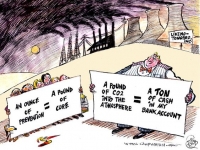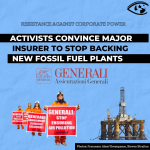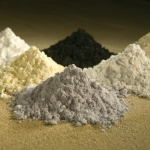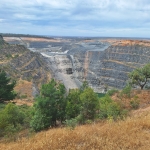Carbon: Under Kyoto, a Hot Commodity

For a backgrounder on carbon trading, see As the Kyoto Protocol comes into force this month, carbon is becoming one of the hottest commodities on the international marketplace, with investors predicting that it could soon become one of the largest markets in the world. The Protocol's "flexible" market-based mechanisms allow corporate polluters to evade their emissions reduction obligations at home by buying up and trading carbon emission quotas and credits from other countries, projects or industries.
The Carbon Brokers, by Pratap Chatterjee.
Critics charge that carbon trading is a smokescreen. At best, it is designed to attain "carbon neutrality"-representing no net growth in emissions for a country or industry, but doing so cheaply. At worst, it may make the warming climate even less stable, while robbing the poor of their rights.
Soumitra Ghosh, who works with forest workers in India, worries that such carbon trading will only further global inequality. It has the potential to set up a system, he says, "wherein the poorest and darkest-skinned pay the highest price- with their health, their land, and, in some cases, with their lives - for continued carbon profligacy by the rich."
Under the Protocol, the UN would distribute pollution rights to 38 industrialized nations. With the exception of the United States, which is boycotting the Protocol, and Australia, these governments are quietly handing out these entitlements free of charge to major corporate polluters in sectors like electricity generation, oil, steel, cement, chemicals, pulp and paper. These pollution rights are tradable, much to the joy of free market advocates and consternation of social and environmental justice critics.
Under the Protocol's Clean Development Mechanism (CDM), one potential way to earn carbon credits involves funding "carbon dioxide saving" projects in the global South. These projects are designed to keep greenhouse gases out of the atmosphere either by preventing their release or by sequestering them. Forests and tree plantations are one of the preferred forms -- and are often called carbon sinks, since trees remove carbon from the atmosphere and sequester it in their wood. Renewable energy projects are also admissible as sinks since they produce energy without burning fossil fuels.
"These new markets for forest carbon offsets can finance rural development investments that help to reduce poverty and conserve biodiversity," claims an advocate of these market mechanisms, the Katoomba Group. The Katoomba Group, launched in 2000, promotes carbon markets, as well as markets for a variety of "ecosystems services." The Katoomba Group includes in its membership banks such as Citigroup, ABN Amro, and the World Bank, corporations such as Coca-Cola, Mitsubishi, and Newmont Mining, and NGOs like the Nature Conservancy and Forest Trends, as well as representatives from government agencies and India's coal-rich state, Orissa. Among the "ecosystem services" Katoomba Group is exploring creating markets for are water, forests, biodiversity, and conservation easements. The group believes that the world's poor have much to gain from participating in forest carbon projects. But not everyone agrees.
Voices of dissent
"Even in purely economic terms, a market in credits from 'carbon-saving' projects will fail," says Jutta Kill of Sinkswatch, a British-based watchdog organization. "You simply can't verify whether a power plant's emissions can be 'compensated for' by a tree plantation or other project. Ultimately investors are bound to lose confidence in the credits they buy from such projects."
Others are bothered by the larger implications of carbon trading. Larry Lohman of the UK-based activist group The Cornerhouse, for instance, sees important ties to property rights. "The distribution of carbon allowances constitutes one of the largest, if not the largest, projects for creation and regressive distribution of property rights in human history," says Lohman.
Also proposed is the planting of genetically modified trees that will grow faster and absorb more CO2. But, says Anne Petermann, of Global Justice Ecology Project, "these franken-trees will lead to the destruction of native forests, worsening global warming."
The World Bank's involvement
Foremost among those set to profit from carbon trading is the World Bank -- also a major financier of fossil fuel developments.
Eight years ago confidential documents were leaked to the Institute for Policy Studies from within the World Bank, revealing the early internal debates around plans for the World Bank to get involved in carbon trading.
That year, the U.S. government was forging Kyoto's "Joint Implementation" trading scheme, in which carbon emission credits were traded exclusively among industrial Northern countries. Brazil and other developing countries countered with the much more intuitive "Clean Development Fund" (CDF). The CDF, based upon the polluter pays principle, would have financed projects in developing countries with levies against industrialized Northern countries that failed to comply with Kyoto's emissions reduction goals. Northern negotiators, wary of any fines, transformed the CDF into the CDM, which proposed a market-based emissions trading scheme.
Here, the World Bank saw opportunity. One leaked document exposed World Bank plans to profit handsomely by charging a five percent commission on carbon transactions, in a self-appointed role as a broker between Northern and Southern governments and industries. (This "commission"- which they now claim is merely to cover their costs - will be closer to 8 or 10 percent.) With a potential market in CO2 that could reach $2 billion by the end of 2005, the World Bank noted in this memo, it could quickly earn $100 million in one year - and that was just for starters.
Neither the signatories of the Climate Convention nor of the Kyoto Protocol had asked the World Bank to play this role - in fact, many, including U.S. Treasury officials, actively discouraged it, recognizing potential conflicts of interest. But the World Bank, rarely accountable to national or international governmental bodies, simply took the task upon itself.
The Bank worked its way into the carbon trading business initially with the Prototype Carbon Fund (PCF), established in July 1999, portraying it as an opportunity to work out the glitches in the CDM before it was launched globally.
PCF Director Ken Newcombe assured concerned NGOs that the PCF would be "entirely renewable." Solar, wind, micro-hydro, and geothermal power projects would make up its portfolio. As time transpired, it became clear that the PCF was far from "entirely renewable," and was, in fact, following the more forthright trajectory laid out in the leaked 1997 World Bank document, namely, pursuing the low hanging fruit in the global carbon market.
Echoes of apartheid
Perhaps the most egregious example currently on the PCF's books is the Bisasar Road Landfill methane capture project. During apartheid-era South Africa, white rulers created the landfill at Bisasar Road in a brown and black community.
The site became a repository of waste, much of it toxic, most of it coming from the more affluent white communities. What was once unspoiled land with resident monkeys and birds in a vibrant community quickly became a foul-smelling, toxic waste dump. Cancer clusters began to emerge in the vicinity of the landfill.
As the apartheid regime was torn down, local community activists raised their hopes and concerns with the ruling African National Congress (ANC). ANC leaders promised in campaign pledges in 1994 to close down the symbol of the apartheid regime, and to clean up the site.
Then along came the World Bank's Ken Newcombe in 2002. He proposed to the mayor of Durban that they profit from methane captured, turning waste gas into electricity-making money both by selling it locally and with money provided by the World Bank's Prototype Carbon Fund. The methane gas that this and other landfill produced could be siphoned off to a power plant, and the city government would be rewarded with 60 million rand over 21 years from northern industries reluctant to reduce their own emissions and eager to buy their way out of the problem.
Sajida Khan lives right next to the Bisasar Road dump. She has suffered two bouts of cancer and lost a nephew to the disease. To Sajida Khan, the PCF represents an undemocratic institution, overruling the will of the local people and the stated ntent of their leaders, the ANC, by effectively bribing them with sorely needed government revenue. While the gas captured may have climate benefits, she argues, to local communities it means noisy generators disturbing nearby school children and other toxic gases - such as benzene and formaldehyde - being spewed into the air from the power plants. Her solution: decommission the dump, create a buffer zone around the dump, and pay for the resettlement of local homeowners. She began organizing her fellow community members, and launched legal challenges and an international campaign to overturn the PCF proposal. However, thus far, her efforts have been met with bureaucratic intransigence.
The Bisasar Road dump is emblematic of the sort of global apartheid carbon trading encourages, allowing Northern governments to profit from over-use carbon in the North while forcing the poorest and darkest skinned in the South to pay with their health and their lives. Worse, because there are no limits on greenhouse gas emissions in the developing world, the sort of emissions trading being proposed by various CDM actors could create perverse incentives for greater inefficiencies - such as allowing more dumps to be built without methane capture as part of their design in order to lure potential carbon traders - and higher overall greenhouse gas emission as a result.
The Bisasar Road project is certainly distasteful, but is not an aberration. Another equally disturbing model for the CDM proposed by the World Bank is emerging in Brazil.
The Plantar project
Plantar, a company located in the state of Minas Gerais, Brazil, owns a monoculture eucalyptus grove, covering 23,100 hectares. The total land owned by Plantar, acquired by pushing local communities off their land under previous dictatorial regimes, is extensive - some 500,000 hectares. The fast-growing eucalyptus trees will eventually be harvested, and used as charcoal for the production of pig iron - a low grade of iron - by the company. For small farmers living on nearby lands, the consequences of this tree plantation are devastating: streams and swamps have dried up, chemicals contaminate the air and water, and the diverse plant and animal species that once inhabited the land have all but vanished.
These plantations are allegedly avoiding the production of 4.3 million tons of carbon dioxide that would have been emitted had coal been used for smelting pig iron rather than charcoal from Plantar's plantations. That's 4.3 million carbon credits that can be sold to a Northern industry that is unwilling to reduce its emissions domestically by the same amount. Is there truly a net benefit? These eucalyptus trees may be destroyed by fire or other natural causes, but they will definitely, within 7-21 years, be cut down for use in pig iron production. The CO2 produced by Northern industries that have bought the PCF's carbon credits, however, will remain in the atmosphere, on average, 50 to 200 years.
Daphne Wysham is a fellow at the Institute for Policy Studies and founder and director of the Sustainable Energy & Economy Network. Part of this article was drawn from a forthcoming article to be published by Grist and Foreign Policy in Focus. It is also a modified excerpt of a report co-authored by Jim Vallette, Daphne Wysham and Nadia Martinez entitled, "Wrong Turn from Rio: The World Bank's Road to Climate Catastrophe."
Carmelo Ruiz-Marrero also contributed to this article.
- 107 Energy
- 194 World Financial Institutions



